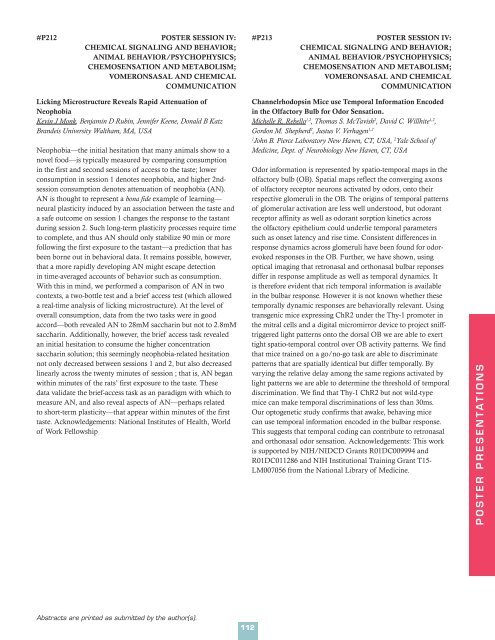Abstracts - Association for Chemoreception Sciences
Abstracts - Association for Chemoreception Sciences
Abstracts - Association for Chemoreception Sciences
Create successful ePaper yourself
Turn your PDF publications into a flip-book with our unique Google optimized e-Paper software.
#P212 POSTER SESSION IV:<br />
CHEMICAL SIGNALING AND BEHAVIOR;<br />
ANIMAL BEHAVIOR/PSYCHOPHYSICS;<br />
CHEMOSENSATION AND METABOLISM;<br />
VOMERONSASAL AND CHEMICAL<br />
COMMUNICATION<br />
#P213 POSTER SESSION IV:<br />
CHEMICAL SIGNALING AND BEHAVIOR;<br />
ANIMAL BEHAVIOR/PSYCHOPHYSICS;<br />
CHEMOSENSATION AND METABOLISM;<br />
VOMERONSASAL AND CHEMICAL<br />
COMMUNICATION<br />
Licking Microstructure Reveals Rapid Attenuation of<br />
Neophobia<br />
Kevin J Monk, Benjamin D Rubin, Jennifer Keene, Donald B Katz<br />
Brandeis University Waltham, MA, USA<br />
Neophobia—the initial hesitation that many animals show to a<br />
novel food—is typically measured by comparing consumption<br />
in the first and second sessions of access to the taste; lower<br />
consumption in session 1 denotes neophobia, and higher 2ndsession<br />
consumption denotes attenuation of neophobia (AN).<br />
AN is thought to represent a bona fide example of learning—<br />
neural plasticity induced by an association between the taste and<br />
a safe outcome on session 1 changes the response to the tastant<br />
during session 2. Such long-term plasticity processes require time<br />
to complete, and thus AN should only stabilize 90 min or more<br />
following the first exposure to the tastant—a prediction that has<br />
been borne out in behavioral data. It remains possible, however,<br />
that a more rapidly developing AN might escape detection<br />
in time-averaged accounts of behavior such as consumption.<br />
With this in mind, we per<strong>for</strong>med a comparison of AN in two<br />
contexts, a two-bottle test and a brief access test (which allowed<br />
a real-time analysis of licking microstructure). At the level of<br />
overall consumption, data from the two tasks were in good<br />
accord—both revealed AN to 28mM saccharin but not to 2.8mM<br />
saccharin. Additionally, however, the brief access task revealed<br />
an initial hesitation to consume the higher concentration<br />
saccharin solution; this seemingly neophobia-related hesitation<br />
not only decreased between sessions 1 and 2, but also decreased<br />
linearly across the twenty minutes of session ; that is, AN began<br />
within minutes of the rats’ first exposure to the taste. These<br />
data validate the brief-access task as an paradigm with which to<br />
measure AN, and also reveal aspects of AN—perhaps related<br />
to short-term plasticity—that appear within minutes of the first<br />
taste. Acknowledgements: National Institutes of Health, World<br />
of Work Fellowship<br />
Channelrhodopsin Mice use Temporal In<strong>for</strong>mation Encoded<br />
in the Olfactory Bulb <strong>for</strong> Odor Sensation.<br />
Michelle R. Rebello 1,2 , Thomas S. McTavish 2 , David C. Willhite 1,2 ,<br />
Gordon M. Shepherd 2 , Justus V. Verhagen 1,2<br />
1<br />
John B. Pierce Laboratory New Haven, CT, USA, 2 Yale School of<br />
Medicine, Dept. of Neurobiology New Haven, CT, USA<br />
Odor in<strong>for</strong>mation is represented by spatio-temporal maps in the<br />
olfactory bulb (OB). Spatial maps reflect the converging axons<br />
of olfactory receptor neurons activated by odors, onto their<br />
respective glomeruli in the OB. The origins of temporal patterns<br />
of glomerular activation are less well understood, but odorant<br />
receptor affinity as well as odorant sorption kinetics across<br />
the olfactory epithelium could underlie temporal parameters<br />
such as onset latency and rise time. Consistent differences in<br />
response dynamics across glomeruli have been found <strong>for</strong> odorevoked<br />
responses in the OB. Further, we have shown, using<br />
optical imaging that retronasal and orthonasal bulbar reponses<br />
differ in response amplitude as well as temporal dynamics. It<br />
is there<strong>for</strong>e evident that rich temporal in<strong>for</strong>mation is available<br />
in the bulbar response. However it is not known whether these<br />
temporally dynamic responses are behaviorally relevant. Using<br />
transgenic mice expressing ChR2 under the Thy-1 promoter in<br />
the mitral cells and a digital micromirror device to project snifftriggered<br />
light patterns onto the dorsal OB we are able to exert<br />
tight spatio-temporal control over OB activity patterns. We find<br />
that mice trained on a go/no-go task are able to discriminate<br />
patterns that are spatially identical but differ temporally. By<br />
varying the relative delay among the same regions activated by<br />
light patterns we are able to determine the threshold of temporal<br />
discrimination. We find that Thy-1 ChR2 but not wild-type<br />
mice can make temporal discriminations of less than 30ms.<br />
Our optogenetic study confirms that awake, behaving mice<br />
can use temporal in<strong>for</strong>mation encoded in the bulbar response.<br />
This suggests that temporal coding can contribute to retronasal<br />
and orthonasal odor sensation. Acknowledgements: This work<br />
is supported by NIH/NIDCD Grants R01DC009994 and<br />
R01DC011286 and NIH Institutional Training Grant T15-<br />
LM007056 from the National Library of Medicine.<br />
POSTER PRESENTATIONS<br />
<strong>Abstracts</strong> are printed as submitted by the author(s).<br />
112
















